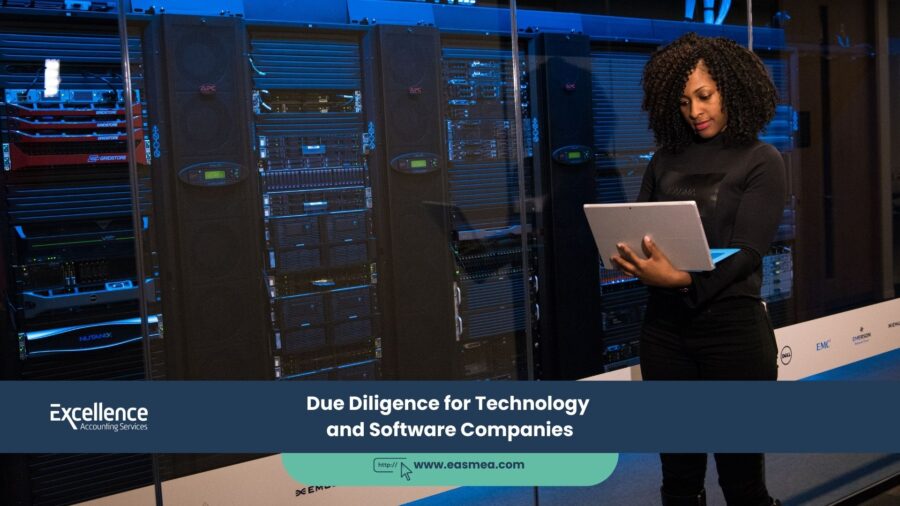A Guide to Due Diligence for Technology and Software Companies
In the fast-paced world of technology, mergers and acquisitions (M&A) are a primary driver of growth, innovation, and market consolidation. Whether it’s a tech giant acquiring a promising startup or a private equity firm investing in a mature SaaS business, the stakes are incredibly high. Unlike traditional industries, the value of a technology company is often tied up in intangible assets: its code, its intellectual property (IP), its user data, and the talent of its engineering team.
This reality means that due diligence for a technology company is a fundamentally different and far more complex exercise than for a traditional business. A standard financial and legal review is no longer sufficient. A potential buyer or investor must go deeper, conducting a highly specialized investigation into the core technology, the product, and the unique risks associated with the digital landscape. Failing to do so can lead to acquiring a business with crippling technical debt, a flawed product, or a ticking time bomb of a security vulnerability.
This guide provides a comprehensive framework for conducting due diligence on technology and software companies in the UAE. We will explore the critical areas of investigation, from code quality and IP ownership to cybersecurity posture and SaaS financial metrics, that are essential for making an informed investment decision.
Key Takeaways
- Value is Intangible: Tech due diligence focuses on intangible assets like code, IP, and data, which requires a specialized approach beyond traditional financial audits.
- Technical DD is Non-Negotiable: This involves a deep dive into the software architecture, code quality, scalability, and “technical debt” to assess the true health and future cost of the technology.
- IP Ownership is a Deal-Breaker: A key focus is ensuring the company unequivocally owns all its critical code and is not infringing on third-party IP, especially through the misuse of open-source software.
- Financials are Different: Financial due diligence for a SaaS company focuses on key metrics like Monthly Recurring Revenue (MRR), Annual Recurring Revenue (ARR), churn, and unit economics (LTV/CAC).
- Cybersecurity is a Major Risk: A thorough assessment of the company’s cybersecurity posture and data privacy compliance (e.g., with UAE PDPL) is essential to avoid inheriting a major liability. This is a core part of any modern due diligence process.
Why Tech Due Diligence is a Different Beast
If you were buying a factory, you would inspect the machinery, review the maintenance logs, and appraise the physical building. In a tech company, the “machinery” is the code. It is invisible to the naked eye and its quality can only be assessed by experts. The due diligence process must therefore be expanded to include several specialized streams of investigation.
In a tech M&A, you’re not just buying a business; you’re buying a complex, living ecosystem of code, data, and talent. Your due diligence must reflect that complexity.
The Core Components of Tech Due Diligence
A comprehensive due diligence process for a software or technology company is a multi-layered investigation.
1. Technical Due Diligence
This is the “code audit.” It’s a deep dive into the health, quality, and scalability of the company’s software, usually conducted by a specialized third-party firm.
- Code Quality and Architecture: Is the code well-documented, clean, and maintainable? Is the architecture modern and scalable, or is it a monolithic, legacy system that will be difficult to update?
- Technical Debt: This is the implied cost of rework caused by choosing an easy (limited) solution now instead of using a better approach that would take longer. High technical debt is a major red flag, as it represents a significant future cost for the acquirer.
- Scalability and Performance: Can the platform handle a 10x or 100x increase in users and data? The review will involve stress testing and analyzing the infrastructure.
- The Engineering Team: Assessing the skills, processes, and culture of the development team. Are they following best practices like agile development and continuous integration?
2. Intellectual Property (IP) Due Diligence
This investigation confirms that the company truly owns its most valuable asset: its intellectual property.
- IP Ownership: Verifying that the company has clear, undisputed ownership of its codebase. This includes checking that all employees and freelance contractors have signed IP assignment agreements.
- Open-Source Software (OSS) Audit: Almost all modern software uses open-source components. An audit is essential to identify all OSS libraries being used and to check their licenses. Some “copyleft” licenses can legally require you to make your proprietary code public if you use them, which can destroy the value of the company.
- Patents and Trademarks: Reviewing all registered patents and trademarks and assessing any potential infringement risks.
3. Product and Commercial Due Diligence
This assesses the product itself and its position in the market.
- Product Roadmap: Reviewing the company’s plan for future features and development. Is it realistic? Does it align with market needs?
- User Metrics: Analyzing key product metrics like user engagement, retention rates, and churn rates. High churn is a major warning sign that the product is not delivering value.
- Competitive Landscape: A deep dive into the product’s features compared to its competitors. Does it have a sustainable competitive advantage?
4. Cybersecurity and Data Privacy Due Diligence
In an age of data breaches, this has become a critical, deal-breaking area of investigation.
- Security Posture: Assessing the company’s defenses against cyberattacks. This includes penetration testing, reviewing security policies, and checking for past security incidents.
- Data Privacy Compliance: Ensuring the company complies with relevant data protection laws, such as the UAE’s Personal Data Protection Law (PDPL) and Europe’s GDPR if applicable. Non-compliance can lead to massive fines.
5. Financial Due Diligence (The SaaS Edition)
While traditional financial due diligence is still required, for a software company (especially SaaS), the focus is on specific recurring revenue metrics.
- Revenue Recognition: Ensuring that revenue, particularly subscription revenue, is being recognized correctly according to accounting standards.
- SaaS Metrics Analysis: A deep dive into the key drivers of a SaaS business:
- MRR/ARR (Monthly/Annual Recurring Revenue): The predictable, recurring revenue from subscriptions.
- Customer Churn: The rate at which customers cancel their subscriptions.
- Unit Economics (LTV/CAC): The ratio of a customer’s Lifetime Value (LTV) to the Customer Acquisition Cost (CAC). A healthy SaaS business should have an LTV that is at least 3x its CAC.
Navigating Tech M&A with Excellence Accounting Services (EAS)
While technical and IP due diligence require specialized engineering and legal experts, the financial and commercial aspects are where a strategic advisor is crucial. EAS provides the financial acumen to support your tech M&A activity.
- Financial Due Diligence for Tech: Our team is experienced in the nuances of SaaS accounting and financial metrics. We conduct rigorous due diligence on MRR, churn, and unit economics to validate the financial health of the target.
- Valuation of Tech Companies: We provide expert business valuation services that use appropriate methodologies for high-growth, recurring-revenue businesses.
- Strategic CFO Services: We can act as your strategic financial advisor throughout the transaction, helping you interpret the findings from all due diligence streams and assess their impact on the deal price and structure.
Frequently Asked Questions (FAQs)
Technical debt is a metaphor for the long-term consequences of poor software development choices. Taking shortcuts to release a feature quickly might seem efficient now, but it creates code that is messy and difficult to build upon later. High technical debt means the new owner will have to invest significant time and money just to fix the existing foundation before they can build new features.
The biggest red flag is the discovery of code being used under a restrictive “copyleft” license, like the GNU General Public License (GPL). These licenses can legally obligate the company to make its own proprietary source code publicly available, effectively destroying its core intellectual property.
This involves more than just looking at resumes. The due diligence team will typically interview key engineers, review their development processes (e.g., agile, scrum), and look at their code contribution history. The goal is to assess their technical skill, their efficiency, and the overall health of their engineering culture.
Many high-growth SaaS companies are not yet profitable because they are investing heavily in sales and marketing to acquire customers. For these companies, the quality and predictability of their recurring revenue (ARR) and their ability to retain customers (low churn) are the best indicators of future profitability and long-term value.
Yes. Due diligence is about uncovering risks, not necessarily finding a “perfect” company. If issues are found (e.g., high technical debt), the buyer can use this information to negotiate a lower purchase price to account for the future costs of fixing the problem. The deal only falls apart if the issues are deemed too severe or fundamental to fix.
This is a highly specialized field. It is almost always conducted by a third-party consulting firm that specializes in technical due diligence. They have the expertise and proprietary tools to analyze codebases and architectures efficiently.
A security assessment is a broad review of a company’s security policies, procedures, and architecture. Penetration testing (or “pen testing”) is a part of that. It’s an authorized, simulated cyberattack on a computer system, performed to evaluate its security. It’s like checking the locks on the doors versus actively trying to break them down to see if you can.
You must review the contract signed with the freelancer. The contract must contain a clear “work for hire” clause that explicitly states that the company owns all intellectual property created by the freelancer during the engagement. Without this, the freelancer could legally claim ownership of the code they wrote.
LTV stands for Customer Lifetime Value (the total revenue a business can expect from a single customer). CAC stands for Customer Acquisition Cost (the cost of acquiring that customer). The LTV/CAC ratio is a critical measure of the profitability and efficiency of a SaaS company’s sales and marketing engine. A ratio of 3x or higher is generally considered healthy.
For a moderately complex software company, a comprehensive due diligence process involving technical, IP, financial, and legal streams can take anywhere from 4 to 8 weeks.
Conclusion: Investing in Certainty
Due diligence in the technology sector is an investment in certainty. It is a complex but essential process that peels back the layers of a software company to reveal the true quality and risks of its underlying assets. By conducting a thorough, multi-faceted investigation, buyers and investors can make decisions based on a clear-eyed understanding of the technology they are acquiring, ensuring that a promising opportunity doesn’t turn into a costly liability.
Acquiring a Tech Company? Know What's Under the Hood.
Contact Excellence Accounting Services to manage the critical financial and commercial due diligence for your next technology transaction.




